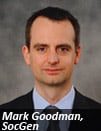Société Générale is rolling out new algo functionality that lets institutional investors improve execution performance by avoiding high-frequency trading (HFT) strategies.
The new tool, called Smart Hit, is an ‘algo manager’ that sits on top of the French broker’s existing algorithmic trading suite. It is specifically designed to mitigate the risks associated with using passive orders in markets characterised by a large proportion of HFT.
“The changing nature of market participants that trade across stock exchanges and multilateral trading facilities means the common assumption that passive orders typically capture half the spread is actually more nuanced,” Mark Goodman, head of quantitative electronic services, Société Générale, told theTRADEnews.com. “We have tried to counteract this through greater use of aggressive orders that use the same signals and models used by HFT firms.”
According to SocGen analysis, some HFT firms see passive orders from institutional money managers as a source of profit when looking for trends in rising markets, or use them as a type of ‘insurance policy’ to close out positions when they need to exit the market.
If either of these scenarios arises, institutional investors may have to increase their aggression to complete orders before they are disadvantaged by HFT firms, which can add to execution costs.
Reading the signals
Smart Hit measures the strength of market signals, such as volatility and price prediction models based on correlated instruments, and uses this to determine the best time for institutional investors to trade and avoid flow which could be considered toxic.
If a market signal is deemed to be very strong and therefore attractive to HFT firms, the algo will avoid competing. For medium signals that may not prove to be as profitable for HFT firms but are also not necessarily being monitored by other agency brokers, the algo will increase its participation.
Goodman added that buy-side firms need to recognise the speed advantage held by HFT firms to optimise execution performance.
“Given that we are an agency business, we need to balance the need to wait for a good market signal to trade and the urgency of an order,” said Goodman. “Brokers need to recognise that HFT firms will always be faster. Options for co-location are limited for many sell-side firms that need to optimally locate across multiple markets, rather than HFT firms that focus on a single-venue strategy.”
A number of other brokers have also calibrated their algorithms to help the buy-side deal with HFT flow. In April last year Deutsche Bank unveiled Stealth, a strategy that uses short-term indicators – such as stock valuation and order placement – to offer buy-side traders similar tactics to those used by electronic market makers and statistical arbitrage traders. In May this year, Wedbush Securities, a US full service brokerage announced it had signed 10 buy-side firms to its new execution service that offered institutional investors the same technological capabilities as HFT firms.
